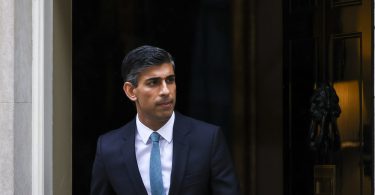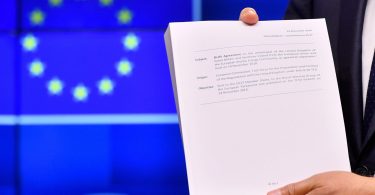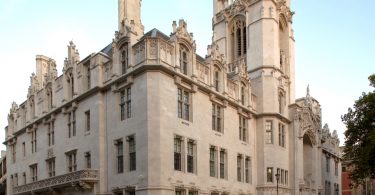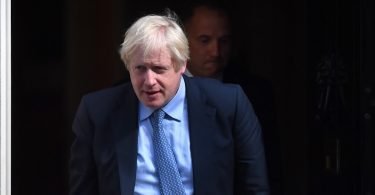The Attorney General’s advice to the Cabinet on the Northern Irish “backstop” has been in the news, with demands for it to be made public. Here, Martin Howe QC, Chairman of Lawyers for Britain, sets out his own advice to the Cabinet about what they need to consider if they are thinking of agreeing a backstop with the EU which is subject to a review mechanism.
On 11 November 2018, the Sunday Telegraph published (subscription access only) a comment piece by Martin Howe containing a summary of this advice.
Theresa May’s backstop plan would drop the UK into a legal black hole
Introduction – what we need to see
Many people are demanding to see the legal advice which the Attorney General gives to the Cabinet about the Irish border “backstop” arrangement. But much more important than seeing the Attorney’s advice is seeing the actual legal text of the deal being negotiated in secret between the UK government and the EU.
There is no valid diplomatic reason for keeping the text secret, since it is known to the other side in the negotiations. I fear that the real reason for this secrecy is to limit the ability of Parliamentarians, lawyers, experts and others to study the details of what is being agreed behind closed doors, and to identify problems and other issues which arise from the detailed provisions of the legal text which may not be apparent from what is in the public domain.
Although important additional issues may arise from the legal text, enough is publicly known about the shape of the “backstop” deal for clear legal advice to be given on the salient points. So this is the advice I would give the Cabinet.
The current “backstop” is not legally binding
First, the baseline of the legal advice is that the existing text about the “backstop” dating from the December 2017 so-called Phase 1 Agreement is not legally binding. This backstop text consists of two ambiguous, confusing and internally self-contradictory paragraphs in a Joint Report by the UK and EU negotiating teams. The UK is free under international law to walk away from these paragraphs.
The UK can justifiably say that the concept contained in those paragraphs – of the UK maintaining “full alignment” with areas of EU rules of the Customs Union and Single Market – has proved not capable of being negotiated into a solution acceptable to both sides. Therefore a different approach — of maintaining a customs and regulatory border enforced by behind-the-border measures — should be preferred.
A “backstop” in the Withdrawal Agreement would be legally binding
If a backstop arrangement is taken forward and put into a treaty text, it will become legally binding. If we sign a treaty committing the UK to operate a backstop arrangement, is not realistic to say (as some have) that it is just a treaty and we can either change it in future or just leave it or even break it. Under international law, we cannot change the treaty or legally leave it unless its terms allow us to do that. As a trading nation which is dependent upon asking other nations to honour the treaties we sign with them, we cannot afford simply to breach a treaty of this kind.
But trade treaties normally contain clauses which allow either party to withdraw on giving notice – typically 12 months. Indeed, I can’t think of a single existing trade treaty which does not contain such a notice clause.
So what the EU is currently asking for – a clause which would allow the UK to terminate the backstop only if the backstop is replaced by a subsequent agreement with the EU – is wholly exceptional in international trade treaty practice. This would lock the UK into a relationship with the EU which the UK could not escape except with the EU’s permission.
It appears that that relationship would involve obligations to follow the EU’s rules on external tariffs and customs, on so-called “level playing field” measures relating to state aids, the environment, employment and other areas, and (according to latest news reports) a continuing obligation to maintain access for EU boats into UK fishing waters.
Further, these would be obligations to follow EU rules not as they stand today but as they are altered in the future. Unlike now, we would have no vote or veto on changes to these rules. So they could be altered (intentionally or not) in ways which damage British businesses compared with their Continental competitors. The rules would also be subject to unpredictable changes of interpretation as a result judgments of the ECJ, a court on which we will no longer have representation.
This exclusion of the right of Parliament to make laws for the UK according to the democratic wishes of the people could only be constitutionally acceptable if the UK had the effective ability to exit the arrangement without delay, if Parliament so decides.
The backstop’s effects on negotiations with the EU
When entering into a legal agreement, one has to consider how the other party is likely to exercise the rights you concede to it under the agreement. The above backstop terms would be highly attractive to the EU, which currently sells £95bn per year more goods into the UK market than we sell to them. The tariff and non-tariff barriers of the EU single market and customs union make it more difficult and costly to import competing goods from non-EU countries, so EU27 producers are able to sell this large surplus of goods into the UK market at significantly above world prices.
These “backstop” terms would force the UK to keep in place the barriers against competing goods from non-EU countries entering the UK market. The “level playing field” terms would suppress the competitiveness of UK industry. So the EU would have a huge incentive to keep the backstop in place for as long as possible, in order to maximise its own goods exports into the UK market and the prices that EU producers would be able to charge on those exports.
This would have two effects on negotiations. First, the EU would have no incentive to agree terms in a replacement long-term trade agreement which are any better for the UK than the backstop terms. This would make it impossible in practice to negotiate away the “level playing field” restrictions and barriers against non-EU imports when concluding a long term trade agreement with the EU. Why should the EU concede terms which are worse for the EU in the trade agreement, than it can get simply by not agreeing a trade agreement and letting the “backstop” come into force?
Secondly, the EU would have a massive incentive to keep the UK locked into the backstop for as long as possible. This means that if some kind of arbitration process is adopted in order to allow the UK to leave the backstop, the EU could be expected to fight the arbitration vigorously and to string out the arbitration processes as long as possible. The EU is very practised at conducting international trade arbitrations, and is very skilled at stringing them out for literally years with obfuscation and delaying tactics.
A “joint review mechanism” or independent arbitration
It now seems that instead of pressing for a simple clause which gives the UK the right to withdraw from the backstop by giving notice, the government is contemplating a clause under which the UK’s right to withdraw is dependent upon satisfying some kind of ‘joint review mechanism’ or independent arbitral body.
This requires legal advice to the Cabinet on four questions: (1) What body is to take the decision? (2) According to what processes and in particular in what timescale? (3) What is the criterion for release from the backstop to be applied by this body? And finally, (4) how confident is the government of its ability to meet the criterion, and demonstrably prove that it has met it, within a reasonably short timescale?
As to what body is to take the decision, it is virtually unheard of in international treaty relations for states to agree to be bound by decisions of tribunals which are not strictly neutral. Typically, an international arbitration panel will consist of an arbitrator appointed by each party and a neutral chairman. However, the Chequers White Paper has proposed an arbitration process modelled on the humiliating process imposed by the EU on the former Soviet republics of Ukraine, Moldova and Georgia, under which a supposedly independent arbitration panel is obliged to refer issues of EU law to the ECJ and is bound by the ECJ’s decision.
It would be simply unacceptable and contrary to all international practice if the ECJ were to be involved in this way in an arbitration which governed whether or not the UK was permitted to leave the backstop and regain control of its own laws and of its external trade policy. In addition, a procedure which involves referring issues to the ECJ could add 18 months or longer on top of time needed for the rest of the arbitration process.
The timescale of the arbitration would be very dependent on what was the agreed criterion, and on how simple or complex it was to apply it. As a rough guide, the average time for trade disputes to be decided by World Trade Organisation panels in 2007-2011 was over 2 years, despite the fact that applying the theoretical time limits under the WTO disputes rules would have produced much faster results. (See WTO dispute settlement system: a Statistical Analysis by Arie Reich, European University Institute).
In practice where arbitrations involve complex and difficult issues with conflicting evidence and arguments from the parties, the procedures just cannot be made to fit within unrealistically short timescales laid down by rules.
So even if the EU were willing to agree to short timescales for an arbitration process being written into the backstop deal, the UK could not rely on such timescales being adhered to in a real arbitration. So a big risk factor to be considered by the Cabinet is the prospect of the UK being locked into the backstop for a lengthy period while an arbitration drags on, even assuming the right result is achieved in the end.
The next point to consider is what criterion is to be applied? How clearly defined and objective can it be? It seems that the UK government wants to suggest that the Facilitated Customs Arrangement (FCA) in the Chequers White Paper would be effective in ensuring that all goods imported into the UK will be subject to the correct EU import tariff (to be levied by UK customs and paid over to the EU) if the goods are re-exported over an open UK/EU border into the EU.
A dual-tariff scheme of this kind has not been tried before anywhere in the world. It appears that it would operate using a system under which some goods would be charged the higher EU level tariff on entry to the UK, and then given a rebate on proof that they had been consumed in the UK. Other goods would be let in at UK level tariffs, with systems in place supposedly to track them and prevent them from migrating into the EU.
The EU is understandably suspicious about the workability and effectiveness of this untried scheme. It fears that goods on which only UK level tariffs had been paid – which would be zero tariffs where goods are imported from a country with which the UK has a Free Trade Agreement – could be diverted by traders into the EU market. So a big difficulty is in coming up with an objective criterion against which the effectiveness of the FCA can be demonstrated which satisfies the EU’s concerns.
But there is a bigger problem when it comes to the question of whether the UK can be confident that it would be able to meet any such criterion within a reasonable timescale. The UK government seems to accept that it cannot get this new and untried system working before the end of the transition period in 2020. Last June, it sent a technical note to the EU which said that “the UK expects the future arrangement to be in place by the end of December 2021 at the latest.”
But third party observers are far more pessimistic about this system. CLECAT, the professional customs body whose members handle 80% of European customs transactions, believe that it would require five to ten years before it can be applied in practice, and that timescale would be dependent on developing systems which do not exist at present. Experts from the UK Trade Policy Observatory at Sussex University cannot make sense of the government’s figures for the goods that would be covered by scheme and believe that the difficulties of tracking goods are much greater than the Chequers White Paper acknowledges: see Decoding the Facilitated Customs Arrangement by Prof L. Alan Winters CB.
The upshot is that the government can have no confidence about when it would actually be in a position to satisfy the criterion and initiate the procedure for exiting from the backstop, let alone how long an arbitration would take and whether it would ultimately be successful. So the realistic legal advice which must be given to the Cabinet is that an exit clause which requires the UK to satisfy a criterion on the lines above would be likely to lock the UK into the backstop for a number of years. This is on an optimistic scenario in which the untried new customs procedures do not throw up unexpected problems, and the new IT systems are all built and go live on time – not a common scenario for public sector IT systems.
Impact of the backstop on trade relations with non-EU countries
The impact of such a backstop arrangement on the UK’s legal relations with other countries also needs to be considered. While the backstop is in operation, it would be impossible for the UK to implement free trade agreements with non EU countries because we would not be allowed to remove tariffs on goods from those countries. In theory we would be free to negotiate such agreements, to come into force when the backstop ends.
But if it escaping from the backstop is all dependent on an arbitration procedure, we would be unable to tell prospective non-EU free trade partners when we would be free to implement a deal with them. Indeed, we could not tell them any certainty whether we would be able to implement a deal at all. The likelihood is that prospective free trade partners would think it a waste of time to negotiate with us at all, and tell us to go away until we had actually succeeded in getting out of the backstop.
Conclusion
So my advice to the Cabinet is that agreeing to a backstop which the UK can only leave if we satisfy a review mechanism risks dropping the UK into a legal black hole for probably a number of years – and quite possibly for longer. While in that black hole, we would be subject to EU control of our tariffs and external trade policy and of wide areas of our internal laws, without having any vote on the rules which bind us. We would be unable even to negotiate any meaningful trade agreements with non-EU countries until we could provide them with a certain end date for the backstop.
At present, we have a clear legal right to free ourselves from obeying EU rules and from EU control of our external trade policy by giving two years notice. We have given that notice under Article 50 and we shall be free on 30 March 2019. Under the backstop as contemplated we would be worse off than we are as an EU member because our right to escape from EU laws would no longer be under our control. In the best case it would be subject to severe delay of unpredictable length, and in thew worst case might be dependent on satisfying conditions which we can never successfully achieve.
The final piece of advice I give to the Cabinet is advice which I have given to clients on occasion, who are seemingly intent on some ill-judged course of action. The decision on what to do is up to you, and as your legal adviser I can only point out the legal disadvantages and risks to you as you take your decision. But my own view is that I think you are mad, simply mad, if you pursue this course.








